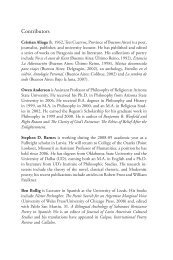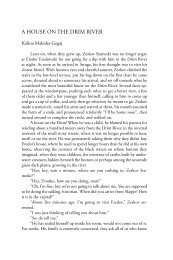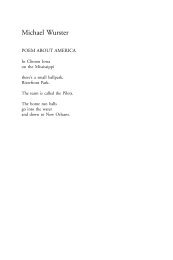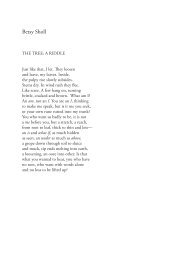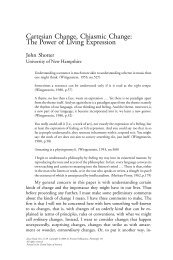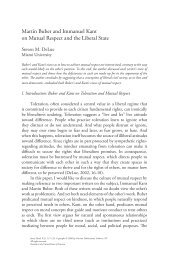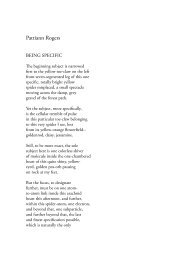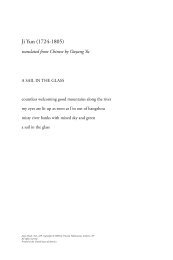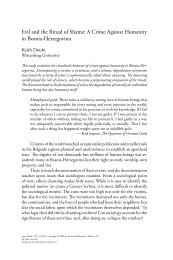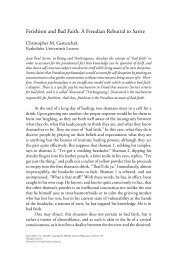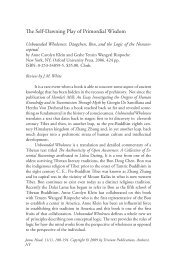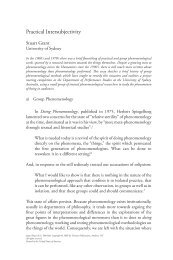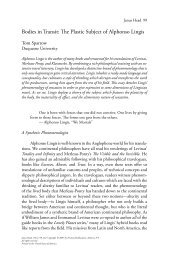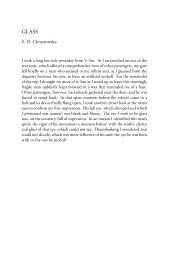Hesse's Steppenwolf: A Comic-Psychological ... - Janus Head
Hesse's Steppenwolf: A Comic-Psychological ... - Janus Head
Hesse's Steppenwolf: A Comic-Psychological ... - Janus Head
Create successful ePaper yourself
Turn your PDF publications into a flip-book with our unique Google optimized e-Paper software.
124 <strong>Janus</strong> <strong>Head</strong><br />
the value of rock and roll, free love, and the use of marijuana and psychedelic<br />
drugs. Timothy Leary went so far as to recommend <strong>Steppenwolf</strong> as a guide<br />
to the use of LSD in inducing altered states of consciousness: “�e last part<br />
of <strong>Steppenwolf</strong> is a priceless manual” (quoted in Ziolowski, 1973, p. 12).<br />
“Poetic writing,” ventures Hesse in his 1961 preface to the novel’s<br />
English translation, “can be understood and misunderstood in many ways.<br />
. . . Yet it seems to me that of all my books <strong>Steppenwolf</strong> is the one that was<br />
more often and more violently misunderstood . . .” (1974, p. vii). Hesse<br />
goes on to speculate that one reason for the misunderstanding may lie in<br />
the fact that many of the work’s readers are young people while the problems<br />
that the book deals with are those of a fifty year old man. But then<br />
again, Hesse notes the numbers of his own generation who failed to grasp<br />
the work’s significance. Certainly the book tells of grief and suffering, of<br />
the crisis of modern life; yet, writes Hesse, “still it is not a book of a man<br />
despairing, but of a man believing” (1974, p. viii). �e story tells not only<br />
of the <strong>Steppenwolf</strong>’s “problematic life,” but also of the “Indestructible . . .<br />
world of faith” (Hesse, 1974, p. viii). “I would be happy,” Hesse concludes,<br />
“if many of them were to realize that the story of the <strong>Steppenwolf</strong> pictures<br />
a disease and crisis--but not one leading to death and destruction, on the<br />
contrary: to healing” (1974, p. viii).<br />
“Faith, believing, healing”--with these words Hesse directs attention<br />
to the action which underlies his novel, the action missed by so many of<br />
its readers. �e author asks that we recognize and appreciate the current of<br />
imagination which flows through the <strong>Steppenwolf</strong>’s story. �is is no less<br />
than the perfectly valid request that our interpretation acknowledge the<br />
genre to which the work belongs.<br />
“Literary genres,” writes the philosopher Jose Ortega y Gasset, “are the<br />
poetic functions, the directions in which esthetic creation moves” (1963, p.<br />
112). Genres are the grand metaphors, the archetypal patterns that vitalize<br />
literary works. �e audience’s awareness of the vista of imagination from<br />
which a particular poetic work issues makes a great deal of difference in how<br />
they will view that work. <strong>Steppenwolf</strong>’s vision is not one in which grief, suffering,<br />
and despair hold the dominant place in human existence. Its vision<br />
is not tragic, even in the most common use of the term. �e action of the<br />
psyche, which <strong>Steppenwolf</strong> makes visible, moves in the opposite direction<br />
towards endurance and health; its genre is comedy. Comedy, according to<br />
the literary critic, Louise Cowan—to whose genre theory the present essay is<br />
greatly indebted—speaks of “faith, hope, and love in a fallen world” (1984,




